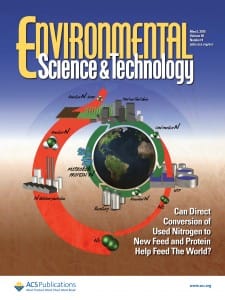Could direct conversion of used nitrogen to human and animal protein help feed the world?
 More efficient processing of used nitrogen to produce food for humans and animal feed could have a marked impact on the word food crisis, according to a recent paper by CRC for Water Sensitive Cities researchers.
More efficient processing of used nitrogen to produce food for humans and animal feed could have a marked impact on the word food crisis, according to a recent paper by CRC for Water Sensitive Cities researchers.
The article, by Resource Recovery from Wastewater (Project C2.1) Project Leader Professor Damien Batstone, PhD candidate Tim Hülsen and colleagues from the University of Queensland, discusses the process of harvesting used nitrogen as single-cell microbial protein. The engaging article was the cover feature for the May edition of the Environmental Science and Technology journal.
While current use of nitrogen for food from available sources operates at about 16% efficiency, the authors argue this new approach could reduce losses in the nitrogen cycle and improve efficiency to almost 100%.
“The increase in the world population, vulnerability of conventional crop production to climate change, and population shifts to megacities justify a re-examination of current methods of converting reactive nitrogen to dinitrogen gas in sewage and waste treatment plants,” the paper states.
“By upgrading treatment plants to factories in which the incoming materials are first deconstructed to units such as ammonia, carbon dioxide and clean minerals, one can implement a highly intensive and efficient microbial resynthesis process. This can be used for animal feed and food purposes.”
Prof Batstone and colleagues note that the technology for recovery of reactive nitrogen as microbial protein currently exists “but a change of mindset needs to be achieved to make such recovery acceptable”.
Citation: Matassa, S., Batstone, D. J., Huelsen, T., Schnoor, J. L., & Verstraete, W. (2015). Can direct conversion of used nitrogen to new feed and protein help feed the world? Environmental Science & Technology. https://pubs.acs.org/doi/abs/10.1021/es505432w